Your Essential Self Publishing Guide
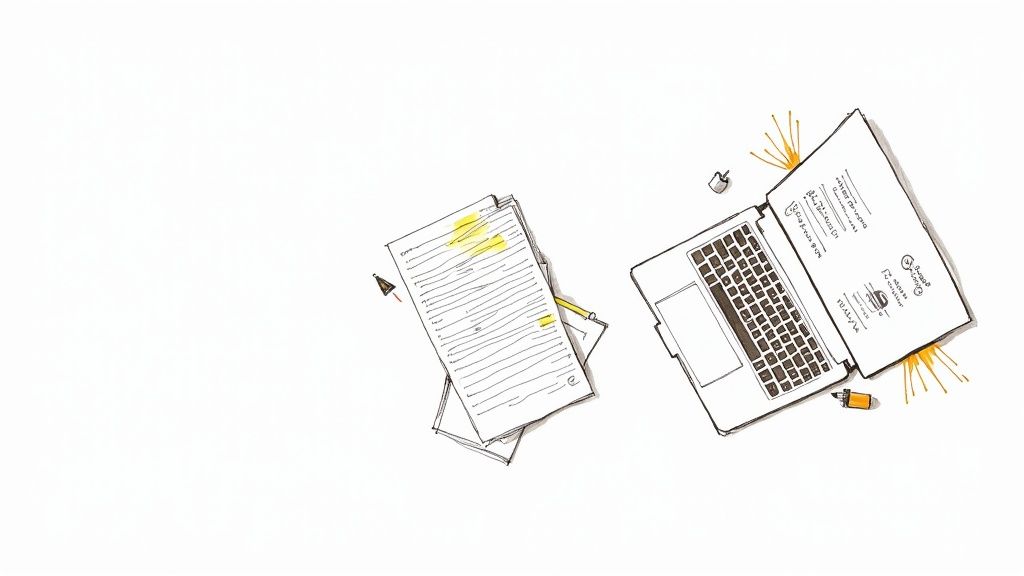
So, you’ve written a book. Congratulations! That alone is a massive accomplishment. But now comes the next big question: how do you get it into the hands of readers? This guide is your roadmap, breaking down the entire self-publishing journey into clear, manageable steps. We'll cover everything from whipping your manuscript into shape and designing a killer cover to choosing the right platforms and kickstarting your marketing.
The Reality of Modern Self-Publishing
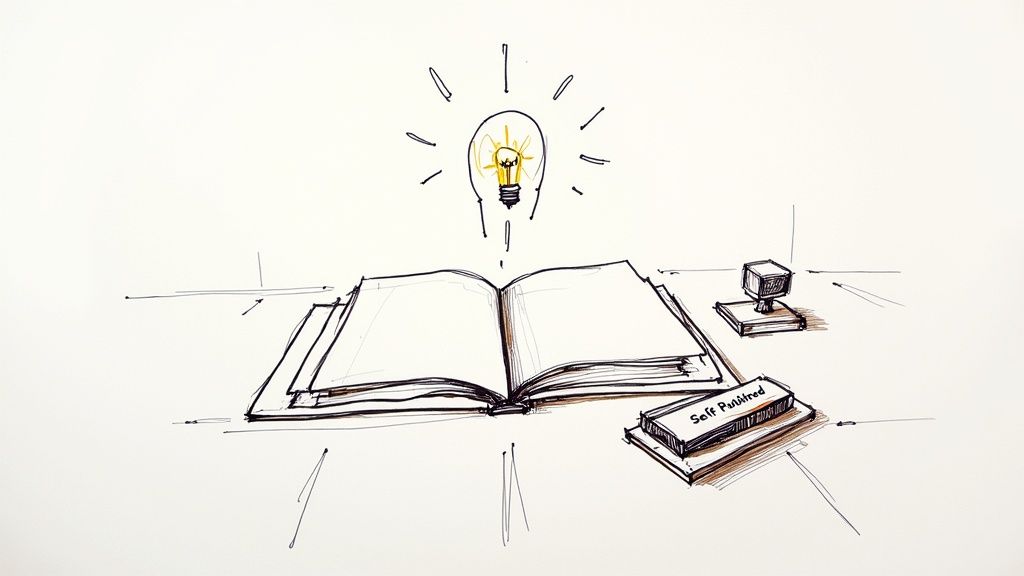
Let's get one thing straight: self-publishing isn't the "vanity press" of yesteryear. It's a booming, legitimate industry where authors are building incredible careers on their own terms. The old gatekeepers are gone. Today, you don't need a permission slip from a big publisher to find your audience and succeed. You just need a great book and a smart strategy.
The numbers back this up. The global online self-publishing market is growing fast, fueled by readers who want books instantly and authors who want more control. You can dig into the specifics in this detailed industry analysis, but the takeaway is clear: this is a fantastic time to be an indie author.
Your Journey as an Authorpreneur
When you decide to self-publish, you're stepping into a new role. You're not just a writer anymore; you're an authorpreneur. This means treating your book like a business and making savvy decisions to give it the best possible chance of success.
It sounds like a lot, I know. But the whole process can be broken down into a series of milestones. Each step logically follows the last, taking you from a file on your computer to a professionally published book earning you royalties.
The real magic of self-publishing is empowerment. You call the shots. You set your own deadlines, you approve the cover, you decide on the price, and you keep 100% of your rights. For many authors, that level of control is everything.
Getting a bird's-eye view of these milestones right from the start helps you plan your time and budget, so there are no nasty surprises along the way.
To help you map out your project, I've put together a table that outlines the core stages of the self-publishing process. Think of this as your production schedule.
Key Milestones in Your Self Publishing Journey
| Milestone | Core Task | Why It Matters |
|---|---|---|
| Manuscript Prep | Professional editing and interior formatting | A clean, polished manuscript is the bedrock of a positive reader experience and good reviews. |
| Cover Design | Creating a professional, genre-specific cover | Your cover is your #1 marketing tool. It has seconds to grab the right reader's attention and scream "quality." |
| Distribution Setup | Choosing platforms (e.g., KDP, IngramSpark) | This decision dictates your book's global reach, how much you earn per sale, and your promotional options. |
| Launch & Marketing | Executing a pre-planned promotional strategy | A strong launch creates vital momentum. Marketing isn't a final step; it's a continuous effort that starts long before publication day. |
Understanding these stages helps you see the bigger picture and approach your book's release with the mindset of a true professional.
The Non-Negotiables for Success
While every author's journey will look a little different, there are a few things that are absolutely essential if you're serious about selling books.
- Professional Editing: There's no way around this. Readers are ruthless when it comes to typos, grammatical errors, and plot holes. A great editor is the best investment you will ever make in your book.
- Market-Ready Cover: Your cover has to look just as good as those from major publishing houses. A homemade cover almost always looks homemade, and it will kill your sales on sight.
- A Marketing Mindset: Hitting the "publish" button and hoping for the best is not a strategy. Success comes from proactively finding and engaging your target audience. Mastering the best social media practices is a great place to start building your author platform.
Ultimately, this guide is here to pull back the curtain on all these steps. My goal is to give you the clarity and confidence you need to take your manuscript and turn it into a book that readers will be excited to buy and recommend.
Getting Your Manuscript Ready for Readers
https://www.youtube.com/embed/jzw5g0RgM3M
So, you’ve typed "The End." That's a huge milestone, and you should absolutely celebrate it. But the journey from a raw draft to a book that readers will love is just getting started. This next phase—the pre-production work—is where you transform your story into a professional product.
Honestly, one of the biggest and most costly mistakes I see new authors make is rushing this part. They're so excited to be done writing that they skip the essential polishing steps. But readers are savvy, and their patience for typos, confusing sentences, or plot holes is incredibly thin.
Think of it this way: professional editing isn't just a nice-to-have. It’s a direct investment in your book's future, influencing everything from reviews to your reputation as an author.
Understanding the Different Kinds of Editing
You wouldn't paint a house before the foundation is set, right? Editing works the same way, building on itself in layers. Knowing the difference between the types of editing helps you figure out exactly what your manuscript needs and who to hire for the job.
It generally breaks down into three main stages:
- Developmental Editing: This is the 30,000-foot view. A developmental editor digs into the big-picture stuff: plot, pacing, character development, and the overall structure of your story. They’re not hunting for misplaced commas; they’re making sure your story’s bones are strong and the narrative works as a whole.
- Line and Copy Editing: Once the story structure is solid, it's time to zoom in on the language itself. Line editing refines your prose, focusing on flow, clarity, and impact at the sentence level. Then, copy editing gets even more granular, correcting grammar, spelling, punctuation, and syntax. These two are often bundled together.
- Proofreading: This is the final, pre-flight check. A proofreader is your last line of defense, catching any pesky typos or formatting glitches that somehow survived the earlier stages.
For a first-time author, a developmental edit can be absolutely game-changing. But if your budget is tight, every self-published author must, at a minimum, invest in professional copy editing and proofreading. It’s the baseline for competing in a crowded market.
Hiring an editor isn't a sign that you're a bad writer—it's a sign that you're a professional author. Every single book from a major publishing house is rigorously edited by multiple people. To stand a chance, you need to hold your work to that same standard.
Professional Interior Formatting
After your words are polished, the way they look on the page is just as important. Interior formatting is the art of designing your book’s pages for both ebook and print. Nothing screams "amateur" faster than wonky spacing, a jarring font choice, or a clunky table of contents. It completely yanks the reader out of the story.
You’ve got a few solid options here:
- DIY with Platform Tools: Services like Amazon KDP have free tools that can turn a Word doc into an ebook. They get the job done, but your creative control is limited, and the results can sometimes look a bit generic.
- Specialized Software: This is where many indie authors land. Tools like Vellum (for Mac users) or Atticus (for everyone) are fantastic. They provide gorgeous, industry-standard templates that let you export perfectly formatted ebook and print files in minutes. The one-time cost pays for itself in time saved and the sheer quality of the final product.
- Hire a Formatter: If your book is more complex—think cookbooks, photography books, or intricate non-fiction—hiring a professional book designer is the way to go. They can create a custom layout that’s both beautiful and functional.
Putting All the Pieces Together
A finished book is more than just the story. You need to wrap it in the standard front and back matter that readers expect to see. These elements frame your work and give it a professional feel.
Before you export your final files, make sure your manuscript is organized with these key parts in order:
- Title Page: Simple and clean—just your book title, subtitle, and your name.
- Copyright Page: This is crucial for protecting your work. Include the copyright symbol (©), the year of publication, your name, and a simple rights statement like, "All rights reserved."
- Dedication (Optional): A brief, personal note.
- Table of Contents (Ebooks): Absolutely essential for digital versions so readers can navigate.
- Your Story: The main body of your book.
- Acknowledgments (Optional): The perfect spot to thank your editor, beta readers, family, or anyone who helped along the way.
- About the Author: A short bio that connects you with your readers. Be sure to include a link to your website or author newsletter!
- Also By (Optional): If you have other books, list them here. It's a simple and effective way to lead readers to your backlist.
By taking the time to edit, format, and assemble your manuscript correctly, you ensure that from the moment a reader opens your book, they're stepping into a professional, immersive world you’ve expertly built for them.
Designing a Book Cover That Actually Sells
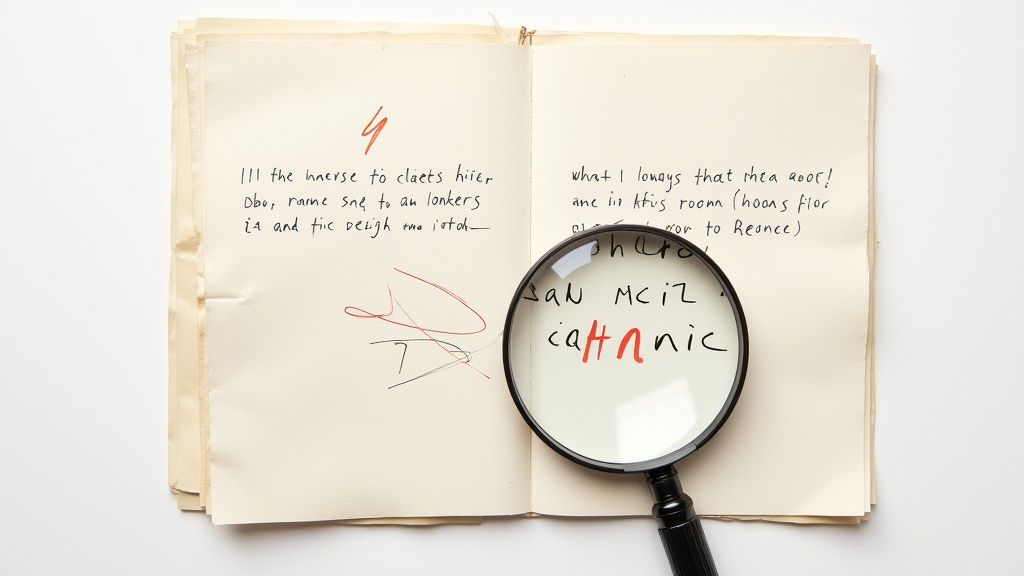
Let's be blunt: people absolutely judge a book by its cover. In the lightning-fast scroll of an online bookstore, your cover is your #1 marketing tool. It has about two seconds to hook a potential reader and communicate your book's genre, tone, and quality.
A great cover makes an instant promise. It says, "If you love gritty detective thrillers, you've found your next read." A bad cover, however, screams "amateur hour" and can torpedo your sales before anyone even glances at your blurb. Nailing the cover is non-negotiable.
To DIY or Hire a Pro?
This is one of the first big forks in the road for a new author. You have three main ways to get a cover, and each comes with its own set of pros and cons regarding budget, time, and creative say.
Hiring a Professional Designer: This is the gold standard for a reason. A real book cover designer is more than an artist; they're a market expert. They know genre conventions, what typography pops, and what imagery sells books. It’s the priciest route, but the right designer can deliver an ROI that pays for itself many times over.
Buying a Pre-made Cover: This is a brilliant middle ground. Designers often sell stunning, ready-to-go covers at a fraction of the custom price. You find a design that fits your story, and the designer simply drops in your title and author name. You get a professional look without the custom price tag.
The DIY Route: Tools like Canva have made graphic design seem easy, but this path is treacherous. Without a solid grasp of design fundamentals, it’s shockingly easy to create a cover that looks cheap and turns readers off.
A professional book designer once told me, "My job isn't to create art. My job is to create a commercial package that convinces a specific type of customer to buy." That shift in mindset is crucial for any author.
The Anatomy of a Winning Cover
A cover that actually sells is a finely tuned machine. It's not just one cool picture; it's a careful blend of typography, imagery, and genre signals all working in harmony.
Typography is arguably the king. Your fonts have to be crystal clear, even when your cover is just a tiny thumbnail on an Amazon search results page. More importantly, the font style itself is a powerful signal. A flowing, elegant script suggests romance, while a chunky, distressed font might scream post-apocalyptic mayhem. For a masterclass on this, you can find some fantastic book cover design tips that really break down the psychology of cover visuals.
The imagery, of course, sets the mood. Whether you use a photograph, a custom illustration, or an abstract concept, it has to evoke the right feeling for your genre. A dark alley is perfect for a mystery; a bright, whimsical drawing is made for a lighthearted fantasy. It's also worth exploring modern solutions; using AI image tools for book covers can be a source of unique and affordable art, but you must ensure the final image is polished and looks professionally rendered.
Why You Can't Ignore Genre Conventions
Imagine you're hunting for a new epic fantasy novel. You're scrolling through covers, looking for dragons, swords, or glowing runes. Suddenly, you see a cover with a pastel background and a picture of a smiling golden retriever. You'd be confused, right? You'd assume it was misplaced and keep scrolling.
That's the power of genre conventions. Readers have a built-in visual shorthand for the types of books they enjoy. Your cover must speak that language to attract your ideal audience.
| Genre | Common Cover Elements |
|---|---|
| Thriller/Suspense | Dark color palettes, high contrast, bold and stark typography, shadowy figures, and a sense of urgency or danger. |
| Science Fiction | Spaceships, futuristic cityscapes, planets, advanced technology, and clean, modern, or stylized fonts. |
| Romance | A couple (often in a partial embrace), soft or vibrant color schemes, and elegant, often script-based, typography. |
| Fantasy | Mythical creatures, swords, glowing magic, epic landscapes, and ornate or serif fonts to convey a historical feel. |
Ignoring these unwritten rules is the quickest way to become invisible. The goal isn't to make a clone of a bestseller, but to design a cover that looks like it belongs on the same shelf.
Choosing Your Publishing Platforms and Distribution
Deciding where to sell your book is one of the biggest strategic calls you'll make as an indie author. This isn't just about uploading a file; it's about choosing the storefronts for your author business. This decision directly impacts your royalty rates, how many readers you can reach, and what promotional tools you get to play with.
The central debate you'll encounter is whether to go "exclusive" with a single giant retailer or "wide" across many different stores. There’s no single right answer here—only the one that fits your personal goals.
The Great Debate: KDP Select vs. Going Wide
The 800-pound gorilla in the room is Amazon’s Kindle Direct Publishing (KDP). They offer an optional program called KDP Select, which asks for a 90-day exclusive digital distribution right for your ebook. In other words, for three months at a time, your ebook can only be sold on Amazon.
Why would you do this? In exchange, Amazon gives you access to some powerful perks:
- Kindle Unlimited (KU): Your book gets enrolled in Amazon's popular "all you can read" subscription service. You get paid for every page a subscriber reads, which can become a massive income stream, especially for authors with a backlist or a popular series.
- Promotional Days: You can run limited-time promotions like "Kindle Countdown Deals" (a tiered, temporary price drop) or offer your book for free for up to 5 days per enrollment period to hook new readers.
Going "wide," on the other hand, means you say no to exclusivity. You make your book available on as many storefronts as possible—Apple Books, Kobo, Barnes & Noble, and countless others. This strategy is all about maximizing your reach and diversifying your income. You build a broader, more resilient fanbase and aren't at the mercy of a single retailer's changing algorithms.
The decision between exclusive or wide often comes down to your genre and long-term goals. Fast-paced genre fiction with multiple books (like romance or thrillers) can do exceptionally well in KU. Authors building a global brand or writing standalone non-fiction may benefit more from the wider reach.
The table below breaks down the pros and cons of each strategy to help you decide which path makes the most sense for your book and your career.
Platform Strategy: KDP Select vs. Wide Distribution
| Feature | Amazon KDP Select (Exclusive) | Wide Distribution (Draft2Digital, etc.) |
|---|---|---|
| Primary Advantage | Access to Kindle Unlimited (KU) and powerful Amazon-only promotional tools. | Diversified income streams and a broader, non-Amazon-dependent reader base. |
| Reach | Massive but limited to Amazon's global ecosystem. | Smaller individual stores, but a combined global reach across multiple platforms. |
| Royalties | 35% or 70% on sales; page-read payments from the KU Global Fund. | Varies by retailer (typically 40-70%), but no page-read income. |
| Promotions | Kindle Countdown Deals and Free Book Promotions. | You control pricing and can run promos on any platform at any time. |
| Risk Factor | High dependency on a single platform ("all eggs in one basket"). | Lower risk; if one store's sales dip, others can compensate. |
| Best For... | Rapid-release series authors, especially in genres like Romance, Sci-Fi, and Thriller. | Authors building a long-term brand, non-fiction writers, and those targeting a global audience. |
Ultimately, choosing a strategy isn't a life sentence. KDP Select operates in 90-day terms, so you can always test it out and switch to a wide strategy later if it isn't working for you.
Understanding Aggregators and POD Services
Going wide doesn't mean you have to spend a week creating dozens of accounts and uploading your book to each store one by one. That's where ebook aggregators come to the rescue.
Services like Draft2Digital or PublishDrive are a lifesaver. You upload your manuscript and cover to their dashboard just once, and they handle distributing it to numerous online retailers for you. Even better, they collect all your royalties and send you a single, clean payment.
For your print book, you'll be using a print-on-demand (POD) service. This is a game-changer—a physical copy of your book is only printed when a customer orders one, so you don't have to mortgage your house to buy a garage full of inventory. The two main players here are KDP Print and IngramSpark.
- KDP Print: This is Amazon's own POD service. It’s incredibly easy to use and integrates seamlessly with your Amazon ebook listing. For selling paperbacks directly on Amazon, it's the no-brainer choice.
- IngramSpark: This service offers much broader distribution for print books. It can get your paperback or hardcover into the catalogs used by thousands of bookstores, libraries, and online retailers worldwide. Many savvy authors use both: KDP Print for their Amazon sales and IngramSpark for everywhere else.
This infographic compares the cost, time, and control involved in DIY versus professional cover design—a critical decision you'll make before you even get to this distribution stage.
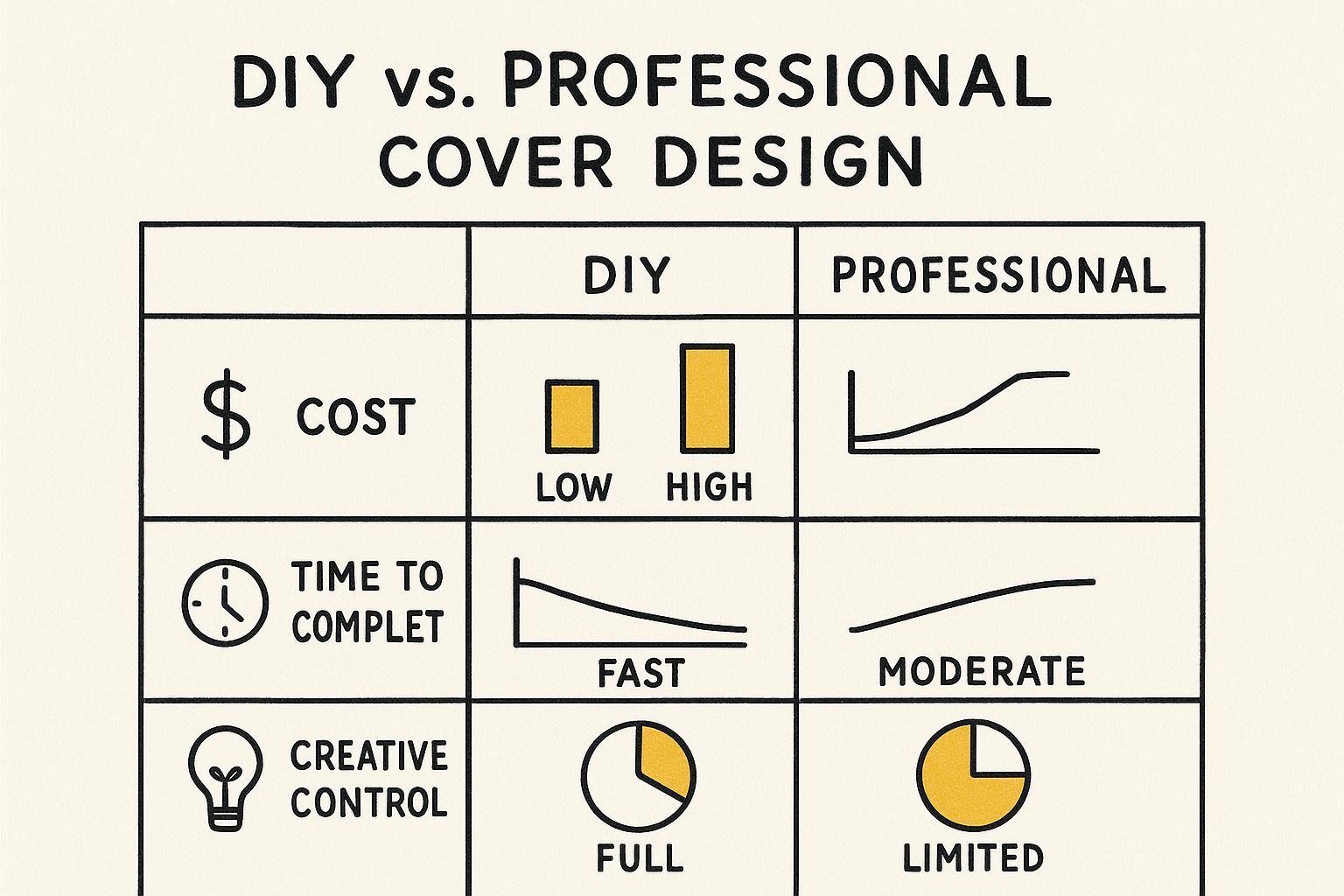
As you can see, while doing it yourself gives you total control for almost no cost, a professional designer delivers a much higher-quality product. In a crowded marketplace, that professional edge is vital.
The ISBN Question and Setting Up Accounts
So, what about that mysterious string of numbers, the ISBN (International Standard Book Number)? Think of it as your book's unique social security number.
If you only plan to publish on Amazon, you can use the free ISBN they provide. Easy. However, if you're going wide or want maximum control over your career, you should buy your own ISBN. In the US, you get these from Bowker.
Owning your ISBN officially makes you the publisher. This gives you complete flexibility to sell your book anywhere you want, on any platform that ever exists, now or in the future. It’s a small investment in your long-term freedom as an author.
Once your strategy is locked in, it's time to create your author accounts on your chosen platforms. This is mostly administrative—providing your name, tax forms, and banking info for those royalty payments. Be meticulous here. Double-check everything to avoid payment headaches down the road.
These choices are the foundation of your book launch. And as you get ready to hit "publish," remember that distribution is just one piece of the puzzle. You'll also need a solid plan for how to promote a self-published book to build the momentum your book deserves.
The Financial Realities of Self-Publishing
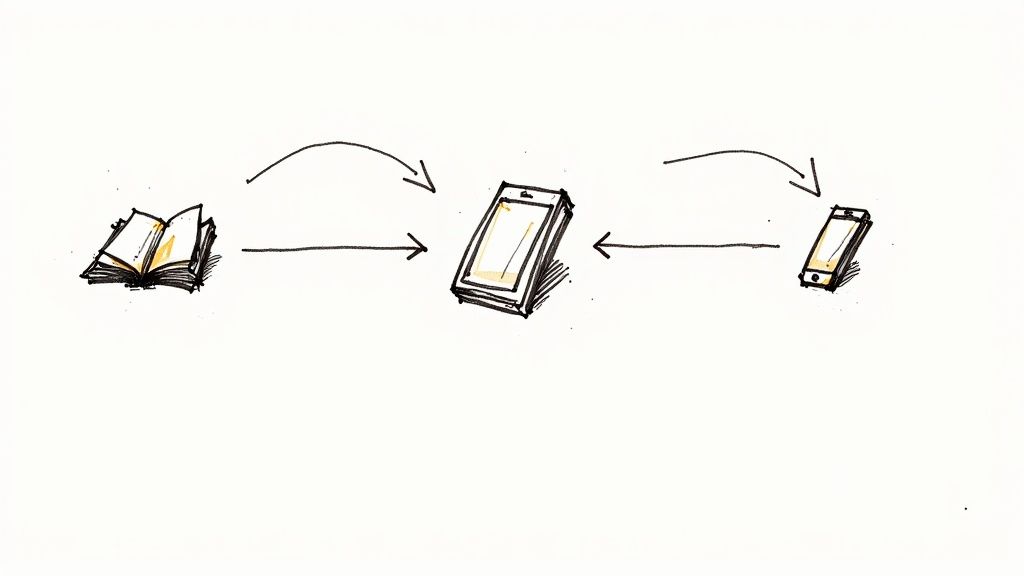
Alright, let's talk about the money. The moment you decide to self-publish, you’re not just an author anymore—you’re the CFO of your own small press. Getting a handle on the financials, from the upfront investment to your potential earnings, is absolutely essential. It’s what separates a professional launch from a costly hobby.
This isn’t about some get-rich-quick fantasy. It’s about building a solid financial roadmap for your book so you can launch it with confidence, manage your budget without panicking, and build a foundation for long-term success.
Budgeting for Your Book Launch
So, the first question on every author’s mind is, "What's this actually going to cost me?" There’s no single answer, of course. The total depends heavily on your existing skills versus what you need to hire out. But one of the biggest mistakes I see new authors make is under-investing in the wrong places, which can cripple a book before it ever finds an audience.
You have to be strategic. Think of it less as a cost and more as an investment in your product.
Investing in your book is a bet on yourself. The goal isn't to spend the least amount of money possible; it's to spend smartly on the things that directly impact quality and sales—namely, editing and cover design.
Recent analysis gives us a realistic starting point. The average cost to self-publish a book in 2025 is estimated to be between $2,940 and $5,660. This range typically covers the non-negotiable professional services that readers expect.
For a deeper look at where those numbers come from, see our guide on how much it costs to publish a book to help you map out your own budget.
Essential Costs vs. Optional Investments
Knowing where to put your money is half the battle. Skimping on editing to buy a stash of branded bookmarks is a classic rookie mistake you want to avoid.
Here’s a practical way to think about your spending:
- Essential (Do Not Skip): Professional editing and a professional, genre-appropriate cover design are the two pillars of your investment. They have the biggest and most direct impact on reader perception and sales. Full stop.
- Highly Recommended: Using dedicated interior formatting software like Vellum or Atticus will give your book a polished, professional look. Buying your own ISBNs is also a smart move, as it gives you more control over your book's distribution and metadata for the long haul.
- Optional (Depends on Goals): Things like audiobook production, a fancy author website, or a big ad campaign can often wait. These are expenses you can tackle later, once you have a book that's selling or you're ready to scale up your author business.
Pricing Your Book and Understanding Royalties
With your beautifully edited and designed book in hand, you now face a new challenge: what to charge for it. This is a delicate dance. If you price it too high, you risk scaring off potential readers. Price it too low, and you can devalue your work and hamstring your earnings.
Your genre, book length, and distribution strategy (going exclusive with Amazon or "wide" to all retailers) will heavily influence your pricing. For indie ebooks, a common sweet spot is between $2.99 and $5.99. This range is popular for a reason—it often qualifies you for the much more favorable 70% royalty rate on platforms like Amazon KDP. Go outside that window, and your royalty rate can plummet to 35%.
A Look at Royalty Structures
Royalties aren't one-size-fits-all. They shift based on the retailer, the book format (ebook vs. print), and your list price. Here’s a general idea of what to expect from the major players:
| Platform/Format | Typical Royalty Rate | Key Consideration |
|---|---|---|
| Ebooks (Major Retailers) | 35% - 70% | The rate almost always hinges on your price. You have to hit specific pricing tiers to earn the higher 70% rate. |
| Print-on-Demand (POD) | 40% - 60% (minus print costs) | Your final take-home is the list price minus the retailer's share and the physical cost of printing the book. |
| Kindle Unlimited (KU) | Per-page-read basis | You're paid out of a monthly global fund, so the exact rate per page fluctuates. This is only an option if you're exclusive to Amazon. |
One last, crucial bit of housekeeping: make sure your tax and payment information is set up correctly on every platform you use. It's a simple administrative task, but getting it wrong can cause major delays in getting paid the royalties you've worked so hard for.
Answering Your Lingering Self-Publishing Questions
Even with a clear roadmap, you're bound to have some nagging questions. These are the practical, "what-if" scenarios that often pop up right when you’re about to hit publish. Let's tackle some of the most common strategic hurdles I see new indie authors face.
Do I Really Need to Buy My Own ISBN?
This question comes up all the time, and it's a big one. It's tempting to just grab the free ISBN from a platform like Amazon KDP, and for some authors, that's perfectly fine.
But here’s the catch: when you use a free ISBN, the platform (Amazon, in this case) becomes the official "publisher of record" for that version of your book. This means you can't use that specific ISBN to sell your book on Apple Books, Kobo, or anywhere else. It effectively tethers that edition to that single retailer.
If you have any ambition to "go wide" and make your book available on multiple storefronts, then buying your own ISBN is a must. When you purchase an ISBN from your country's official source (like Bowker in the US), you become the publisher. This gives you total control and the flexibility to distribute your book wherever you want, both now and in the future.
How Much Should I Budget for Marketing a First Book?
There's no single right answer, but going in with a $0 budget is a recipe for disappointment. A smart, dedicated budget—even a small one—can make all the difference. For a debut launch, many successful authors recommend setting aside anywhere from $200 to $1,000.
Think of this as a strategic investment, not just money you're throwing into the void. This budget could cover high-impact activities like:
- Amazon Ads: Get your book in front of people actively shopping for books just like yours.
- Facebook or Instagram Ads: Reach highly specific reader groups based on their interests and favorite authors.
- Book Promotion Newsletters: Paying for a feature in a service like Fussy Librarian or the coveted BookBub can put your book in front of tens of thousands of readers overnight.
The trick is to be methodical. Start small, track your results obsessively, and double down on what works. A small, targeted budget is far more powerful than a huge, unfocused one.
What Are the Biggest Mistakes New Authors Make?
If you can sidestep the most common pitfalls, you’ll be miles ahead of the competition. Time and time again, I see new self-publishers stumble on the same three things, and any one of them can kill an otherwise fantastic book.
The three cardinal sins of self-publishing are:
- Skipping Professional Editing: Nothing screams "amateur" louder than a manuscript full of typos, grammatical mistakes, or plot holes. Readers are notoriously unforgiving, and a flood of one-star reviews complaining about editing is nearly impossible to recover from.
- A Mismatched Cover Design: Your cover has one job: to look professional and instantly signal its genre to the right audience. A cheap, homemade, or off-genre cover will stop potential readers from even clicking on your book page.
- Ignoring Marketing: So many authors pour their souls into writing the book and then just... stop. They hit "publish" and hope for the best. That’s not a strategy. Marketing is just as important as writing, and the work needs to begin long before your launch day.
Avoiding these three traps is the foundation of a professional author career. Get these right, and you're already in the top tier.
When Should I Actually Start Marketing My Book?
Way earlier than you probably think. Ideally, you should start building buzz at least 2-3 months before your launch. This pre-launch phase isn't about shouting "buy my book!" from the rooftops; it's about creating genuine anticipation and gathering your first true fans.
Your focus here should be on building assets. When authors ask how to get the word out, I often point them toward learning about effective content marketing strategies for small businesses, because many of the same ideas apply directly to building an author platform.
During this pre-launch window, focus on these key moves:
- Build Your Email List: Create a "reader magnet"—a free short story or a prequel—and offer it to people who sign up for your newsletter. This is the most valuable audience you will ever have.
- Engage on Social Media: Don't just post links. Talk to readers in your genre. Join Facebook groups, participate in discussions, and share your writing journey.
- Plan a Cover Reveal: Make a real event out of unveiling your cover. It’s a huge milestone and a fantastic way to generate excitement.
- Assemble an ARC Team: An ARC (Advance Reader Copy) team is a group of volunteer readers who get your book for free before launch in exchange for an honest review on release day. Those early reviews are pure gold.
The goal is to have a crowd of eager readers waiting for you the moment you hit publish. It’s the difference between a silent launch and a real event.
Many authors see marketing as a chore they have to do after the real work is done. Successful authors know that marketing is part of the work—it’s the art of connecting your story with the people who need to read it.
By thinking through these questions now, you can navigate your publishing journey with more confidence. These aren't just details; they are the strategic decisions that will define your career and set you up for long-term success.
Are you ready to stop wrestling with marketing and get back to writing? ManuscriptReport.com turns your manuscript into a complete, launch-ready marketing kit in about 10 minutes. Get everything from blurbs and ad copy to keywords and social media posts, all generated from your book and tailored to your genre. Stop guessing and start selling. Generate your full book marketing report today.
Related Articles

How to Become a Published Author
Discover how to become a published author. Our guide covers manuscript prep, finding agents, and choosing between traditional vs. self-publishing.
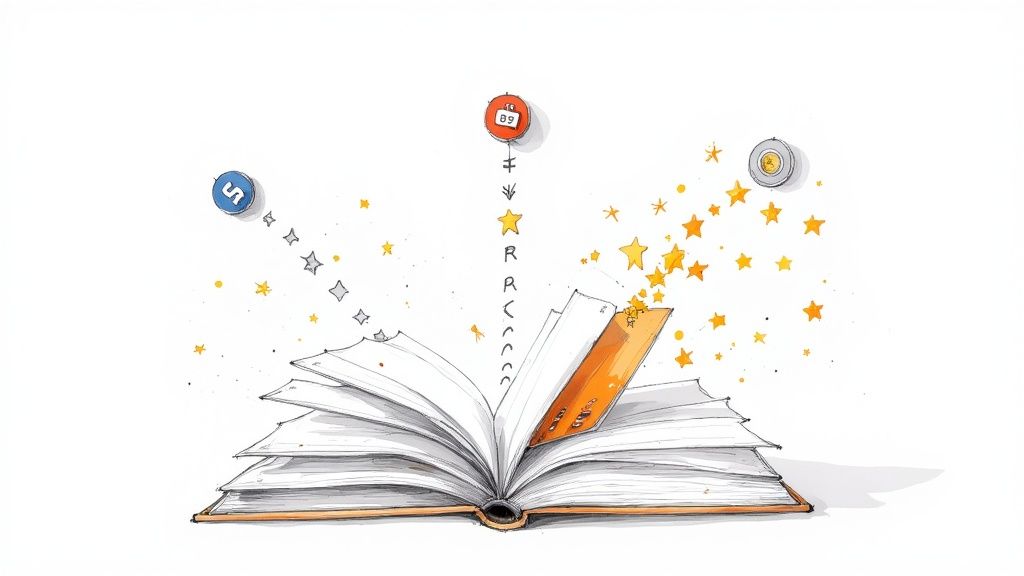
Paying for Book Reviews A Guide for Modern Authors
Is paying for book reviews a smart strategy or a big risk? This guide covers the ethics, best services, and safer alternatives for authors.